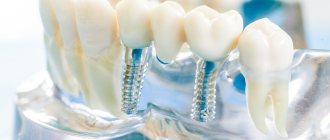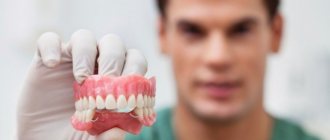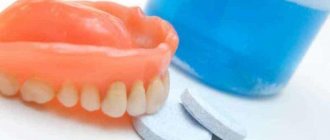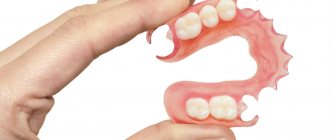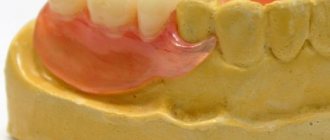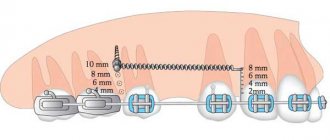Reasons What to do?
When do you need to see a doctor urgently? Methods of treating gums Solutions Advantages of prosthetics on implants Prevention Doctors Work Removable dentures solve many problems: functional (chewing, diction), aesthetic (smile), psychological (no fear of communication). But it also has disadvantages. Unpleasant sensations caused by the gums being rubbed by the denture.
You should not immediately blame the orthopedist; over time, the relief of the oral cavity changes. Due to the absence of teeth, bone tissue atrophy increases, the gums sag, fixation is disrupted, and as a result, correction or a new product is required.
Reasons why removable dentures rub
Even a well-made removable denture takes some getting used to. A foreign object in the mouth causes psychological problems and can also scratch and irritate the gums. Therefore, correction requires several visits, and adaptation – several weeks. But sometimes correction doesn't help.
Removable dentures rub when:
- The manufacturing technology was violated
: the technician did not polish well enough or did not notice the growth, which irritates the mucous membrane and causes discomfort. - The design is poorly fitted
. - The patient has untreated gum disease
: periodontitis can cause the gums under the dentures to become inflamed; it not only provokes inflammation, but also changes the contour of the gums when they swell.
- Gum recession:
due to bone tissue atrophy, trauma, unsuccessful treatment, the gums “sag” and the structure is no longer suitable.
- Service life:
over time, the base becomes covered with microcracks and roughness, which have an irritating effect.
Recommendation #4. Get dental implantation, that is, change your removable denture to a better solution
If you are tired of many uncomfortable moments (and this is not only rubbing of the mucous membranes, but also impaired diction, the inability to eat your favorite foods, the gag reflex, and others) that arise when using removable devices, then it’s time to move to a fundamentally new and higher quality level of life.
Typically, removable systems are worn by people with multiple and complete edentia (when there are no teeth at all). For such patients, the best and most correct solution is to replace removable devices with non-removable ones, fixed on analogues of the roots of natural teeth - implants. And one-stage implantation with immediate loading will help achieve this goal.
When implanted with immediate loading, the prosthesis is installed within 3 days
This approach is good because the patient receives a permanent and fully functional prosthesis, which is securely fixed in the oral cavity already 2-3 days after the implantation of artificial roots. One-stage implantation protocols make it possible to do without bone grafting and without mucosal grafting, and these manipulations in most cases are necessary for those who have used removable dentures for a long time.
Fixed structures, which are fixed to implants according to one-stage treatment protocols, have a beautiful gingival contour, as well as a metal base that stabilizes and unites the entire system into a single whole. Due to this, already during the rehabilitation period the patient begins to eat his favorite foods, smiles freely, and does not worry that the structures will fall out or rub the mucous membrane.
What to do if your denture rubs your gums
Discomfort, burning, and pain should not be tolerated; you should immediately contact an orthopedist. Inflammation of the gums under the prosthesis causes improper fitting, unreliable fastening, periodontal disease, as well as:
- Poor hygiene.
Whether it is a complete denture or a partial one, care for the oral cavity and the product itself must be thorough so that pathogenic microflora does not provoke disease. - Refusal to sanitation
of the oral cavity and dental treatment before prosthetics. Plaque and carious cavities are breeding grounds for microbes, so professional cleaning and treatment are prerequisites for a positive result. - Allergic reactions
. If acrylic is used in the design, then the symptoms may be a manifestation of an allergy to the monomers that are part of it.
First you need to eliminate the cause, and only then adjust the prosthesis; only an orthopedic doctor can do this professionally.
Preventive measures to strengthen gums
In most cases, gum disease caused by wearing orthodontic appliances can be prevented. The presence of a denture implies thorough oral hygiene. After installation of the prosthesis, the patient should follow some recommendations:
- Good oral hygiene involves brushing your teeth at least 2 times a day. Particular attention should be paid to the most inaccessible areas. It is advisable to rinse your mouth after every meal.
- To clean your teeth, you can use either a simple paste and a brush, or special ones. Removing food particles reduces the risk of periodontitis and tooth decay.
- It is recommended to remove the jaw before going to bed. Overnight, your gums will rest from the stress. The structure must be placed in a solution to preserve its functionality and appearance. You can purchase the product at a pharmacy.
- It is useful to massage your gums daily. The procedure stimulates blood circulation, which reduces pain and swelling.
- Extra care won't hurt either. You can use infusions or decoctions of herbs.
It is worth visiting a doctor 2 times a year. Regular examinations will minimize the risk of complications. Strengthening the immune system is of great importance. It is better to give up smoking and chewing gum.
Pain when wearing dentures occurs for various reasons. The main task is to timely identify and eliminate complications. If you do not go to the dentist, undesirable consequences may occur. These include: extensive swelling, severe inflammation, suppuration and loss of remaining teeth. Self-medication can lead to serious complications, which is why you should not get carried away with it. It serves only as first aid before visiting a doctor to alleviate the condition.
Symptoms that require immediate medical attention
Patients often think that if their gums hurt under dentures, then this is normal, so they delay going to the doctor. Swelling and redness appear on the gums. If nothing is done at this stage, erosions and ulcers appear on the mucous membrane. Traumatic (prosthetic) stomatitis develops; drug treatment is needed.
Constant mechanical irritation leads to the formation of papillomas, which can degenerate into tumors.
Burning, discomfort, and unpleasant sensations are sometimes caused by common diseases: diabetes, alcoholism, immunodeficiency states. If you have teeth, in such cases it is better to install clasp dentures, and if this is not possible, then plate products with a soft layer under the base. The soft layer is also used if the palate is rubbed with a prosthesis.
How to sharpen a removable denture at home yourself
What household utensils could be suitable for such a delicate task? Use glass, ceramic or metal MANICURE FILES. The abrasive surface and straight shape of the file will easily remove the elongated edge or the curled edge of the dental plate directed towards the injured gum.
As a rule, over time, chafing occurs on old dentures, precisely at the border, that is, during the correction process the length of the denture is reduced.
But on newly made plates, unexpected pain occurs inside. When handing over a prosthesis, specifically a partial one, the doctor always uses a milling cutter to remove visible undercuts in the plastic. Then, during the adaptation process, abrasions appear on the mucous membrane of the jaw, which are visible to the eye and therefore removable.
Gum treatment methods
Manipulations depend on the reason:
- in case of allergic reactions, the base is changed to hypoallergenic (nylon, AcryFree), antihistamines are prescribed;
- for papillomas, excision surgery is performed;
- when a removable denture rubs, a correction (relining) is made;
- if the crown falls off, it is soldered back.
To soothe gum inflammation, ointments, infusions and lotions are used.
Pharmacy products:
Kamistad, Metrogyl Denta, Solcoseryl, Cholestal, Asepta. These gels and pastes have analgesic and anti-inflammatory effects. Before applying them to your gums, read the instructions carefully.
Disinfectant solutions:
chlorhexidine, furatsilin, destroy pathogenic flora.
Home remedies:
applications of sea buckthorn and rosehip oil. Rinse in the form of infusions of sage and plantain. Solutions of soda and salt also soothe irritation in the mouth.
Comments
What happens if you continue to endure pain? My grandmother wears a removable denture and complains that it has been rubbing a lot lately, but we can’t find convincing arguments for her to finally go to the doctor...
Vera Anatolyevna (10.13.2020 at 21:15) Reply to comment
- Dear Vera Anatolyevna, if you do not take any measures to eliminate the problem, then very painful ulcers will form in the area of rubbing the mucous membrane, and an acute infectious-inflammatory process may also occur, which will gradually lead to necrosis, that is, the death of cells and tissues, osteomyelitis and phlegmon. Systematic tissue trauma can also become a prerequisite for the development of oral cancer.
Editorial staff of the portal UltraSmile.ru (10.15.2020 at 09:27) Reply to comment
How can you generally avoid such situations when the prosthesis begins to rub your gums?
Antipeev Yu.M. (10/31/2020 at 5:17 pm) Reply to comment
- Firstly, only undergo prosthetics from experienced orthopedists. Secondly, when using the prosthesis, follow these rules: after eating food, remove the prosthesis and clean it thoroughly, and rinse your mouth. If discomfort occurs and it does not go away for a long time, consult a doctor who will examine and correct the product. It’s even better if you visit a specialist every six months, undergo preventive examinations and professional hygiene, because artificial teeth require no less attention than natural teeth. And one more piece of advice: if you wear removable dentures, do not forget about dietary restrictions, refuse to eat hard, tough, viscous foods.
Editorial staff of the portal UltraSmile.ru (06.11.2020 at 09:38) Reply to comment
Hello! My dad recently received a removable denture. He says that everything is fine and suits him, like you need to get used to it. But at the same time, it hurts a little to close your jaw, and to eat too. Tell me, should this go away, or is there something wrong with the prosthesis?
Stanislav P. (11/20/2020 at 7:37 pm) Reply to comment
Good evening! Please tell me, are there any contraindications for installing a fixed prosthesis? Can a person develop an allergy to metal during such a procedure?
Anna Novikova (11/20/2020 at 7:39 pm) Reply to comment
Hello! My mother is 72 years old and had dentures installed last year. Everything was fine, but in September he flatly didn’t want to put on implants. He says they are rubbing it. They wanted to take her to the dentist, but now she has a migraine. Question: why did the dentures begin to rub only after almost a year?
Erica (11/20/2020 at 7:58 pm) Reply to comment
Only periodic adjustments will save you from chafing. Because the area of removable teeth can put pressure on the gum in some area. The only option is to cut it down. Then it will be a little easier.
Anton (11/20/2020 at 09:34 pm) Reply to comment
What can you do if after three months you still have discomfort from wearing removable dentures? Sometimes inflammation also appears. Is it possible that the design itself will have to be redone?
Inna (11/20/2020 at 9:46 pm) Reply to comment
Write your comment Cancel reply
Advantages of prosthetics on implants
- Bone tissue does not decrease, the facial contour is preserved, the smile looks younger;
- the supporting teeth do not deteriorate;
- any number of teeth are restored;
- immediately after implantation, a temporary prosthesis or a permanent ceramic-composite structure is put on (using the Resmile method);
- there is no problem with suction (as in removable ones), the structures are fixed with screws or dental cement.
Work of ROOTT dentists on implant prosthetics for periodontal disease
How to treat chafing from dentures
Dentures are rubbing, what should I do? The main thing is not to be discouraged and do not give up. Don't think that other people haven't experienced this phenomenon. However, there is a way out in such a situation. Most often, the following measures can help combat denture chafing:
- Independent “editing” of the prosthesis. Most patients are in no hurry to see a doctor immediately if the prosthesis begins to rub. Here our enterprising people begin to use improvised means such as a small file or sandpaper. Sometimes these methods are effective, especially if the excess plastic on the prosthesis is located at the edge. After cutting off the excess thickness of the plastic base of the prosthesis, it is passed on top with sandpaper for polishing. But with this “home” method, one must be extremely delicate so as not to permanently damage the prosthesis or render it completely unusable.
- Contact the dentist. Many patients who experience pain from chafing while wearing a “removable jaw” seek advice from a doctor who has been involved in the manufacture and installation of dentures. If the prosthesis has just been made, then it would be better to contact a specialist the next day after installation, and then usually several corrections are required over the course of two weeks. It is important, after installing the dentures, not to take them off at night for at least 2 weeks to get used to it as quickly as possible. Some people have to seek correction of their “jaw” up to 10 times, which is quite normal and justified. The main thing here is to achieve maximum patient comfort when wearing these structures.
- How to behave before visiting the dentist. Of course, when the pain in the mouth becomes unbearable, the patient will no longer try to wear the denture. Don’t forget to place the removed dental structure in a disinfectant solution. However, it would be wrong to come to the doctor with the prosthesis removed, as this will not allow identifying the cause of the discomfort. Experts advise overcoming the pain and wearing the structure for at least 3-4 hours so that a clear imprint is formed on the oral mucosa. This will allow the orthodontist to more accurately adjust the dental structure using mechanical action. Most often, special tools such as a carbide cutter are used. After correction, it is better to remove the prosthesis for one day. In this case, it is advisable to rinse with herbal decoctions (calendula, oak grass, yarrow, chamomile, sage) and lotions made from them.
- Use of medicinal oils. Applications with sea buckthorn or rosehip oils are quite helpful for various wounds and abrasions. Oil-moistened wipes should be applied to painful areas for 15-20 minutes three times a day. At this time, the “removable jaw” must be removed.
- Plates. Farmadont collagen plates for gums help with abraded gums. They are often used after mechanical impact on the prosthesis. The plates are applied to painful areas of the mucous membrane three times a day until completely dissolved. Pharmadont plates contain collagen, medicinal plants, and enzymes. They relieve pain and accelerate the regeneration of abrasions.
- Use of gels and creams. Often, after eliminating the cause of chafing, doctors prescribe the following medications: “Kamistad”, “Cholisal”, “Solcoseryl-dent”. It is especially important to use them if prolonged rubbing of the prosthesis has led to the formation of ulcers.
- Sometimes ulcers form at the site where removable structures are worn. They are usually small and can sometimes bleed. More often, ulcers form on the edge of the prosthesis bed. When infected, they may become coated or bleed. If you do not react to their presence, the ulcers can become chronic. The main condition for the treatment of mouth ulcers is the perfect fit of the prosthesis with the elimination of any defects. After adjusting the structures, the ulcers quickly heal.
Attention: if treatment of mouth ulcers does not produce results after 2-3 weeks, consult an oncologist regarding these formations.
- Treatment with honey. Some patients use honey for local treatment of chafing, especially smearing it at night, or propolis tincture diluted in water for rinsing.
- Tantum Verde perfectly eliminates the effects of chafing. It relieves inflammation and pain in the oral cavity. The medicine is used in the form of rinses, sprays or lozenges.
Patient's note. Clasp prosthesis
What unusual sensations await you during the period of adaptation to a clasp denture?
Foreign body effect
This is exactly what your clasp prosthesis is for the body. These feelings are especially acute in the first week after receiving the prosthesis. All your attention may be focused on this feeling for a long time; it may interfere with your work and rest. In people with unstable nervous activity, who can hardly bear the slightest irritation, this feeling gives rise to the desire to remove the prosthesis and abandon it.
Do not do that! Try to be a little patient and every day it will get a little easier.
The effect of “novelty” and the effect of “presence”
You may feel like your denture is taking up all the space in your mouth. There is little room for the tongue, and the lips and cheeks are full and pushed back. You feel the volume and size of the prosthesis.
And this is all due to the design feature of the clasp prosthesis and the presence in it not only of teeth, but also of a metal arch, artificial gum and fixation elements. Such sensations will be new to you, and this is the norm.
Painful sensations in the teeth
It can be expressed in the form of clenching or unclenching of the teeth, pain when chewing and touching the teeth. This is due to the peculiarities of fixation of clasp dentures. And this kind of sensation in the teeth is a normal reaction to the increased chewing load on them. This will go away on its own as the teeth adapt.
Painful sensations in the gums
They will be especially noticeable during chewing and closing teeth. This is a distinctive feature of absolutely all removable structures, since they put pressure on the gums, which is not physiological.
In clasp dentures it is minimal, but still there. If these sensations occur throughout the entire length of the prosthesis, this is normal at first, and you will simply have to get used to it.
If the pain is localized at some point, you will need to come in for correction of the prosthesis. But, before coming, you must wear the prosthesis for at least 3 hours without removing it. During the examination, the doctor will be able to quickly determine the location of the rubbing and make a minimum number of corrections in the future (there may be 3-4).
Unusual sensations when closing teeth
Teeth in a clasp denture may appear “higher” and be slightly palpable when moving the jaw left and right and back and forth. This is because they have a completely new chewing surface that is different from your old teeth. It just takes time to get used to it.
Nausea and vomiting
This is due to the gag reflex, and the prosthesis is an irritant for it. It’s not a problem, just take any sucking lollipops, and these symptoms will disappear very quickly.
Impaired taste and tactile sensations in the mouth
At first, you may not feel the taste and temperature of food so clearly. This is not surprising, since the prosthesis covers part of the mucous membrane. The sensations will be restored, but it will take time.
Salivation disorders
This is expressed in its abundant discharge in the first 2 weeks, dry mouth in the next 2 weeks, and normalization a month after fixing the prosthesis. This is how the body reacts to a foreign body, and these phenomena are quite normal.
Speech Impairment
After fixing the prosthesis, the pronunciation of some words and sounds may be impaired. This is a consequence of restrictions on the movements of the tongue due to the presence of a prosthesis in the mouth. At the end of the adaptation period, everything will be restored. During this period, try to speak more, read aloud and practice pronouncing complex sounds and words.
Mobility of the prosthesis
It is a consequence of the design features of the clasp denture and the shock-absorbing properties of the gum itself. It is for this reason that these prostheses are classified as removable structures. To enhance fixation, you can use special creams (President, Corega, Protefix).
To do this, the denture is thoroughly cleaned, dried with tampons, and the cream itself is applied in broken lines. Afterwards the prosthesis is fixed in the mouth. This cream will also prevent food from getting under the denture.
Chewing and eating
It is with this process that many problems are associated at first, since the clasp denture is structurally very different from your natural teeth. And the sensations during chewing will also differ.
Removable dentures restore only 30-70% of chewing efficiency, with clasp dentures this figure is maximum and amounts to 70%, but you still won’t be able to chew with them as if you were using your own teeth.
In the first days, start with soft food and gradually increase its hardness by 3-4 weeks. It is recommended to eat slowly, in small pieces and not put a lot of food into your mouth at once. This will relieve you of pain in your gums.
Try not to bite with your front teeth at first, but chew food with your side teeth (simultaneously, left and right at once). This type of chewing is not entirely comfortable, but it will prevent the denture from tipping over and falling off. In the future, you will be able to chew on one side, while one of them will be more comfortable (this is your working side), and the second less (this is the auxiliary side). It will not be possible to feel the same comfort when chewing on both sides.
Never eat: very hard, hot or sticky foods.
Caring for clasp dentures
For the longest and most comfortable use of clasp dentures, we recommend that you follow certain hygiene rules, and the most important of them is that the denture must be clean.
This will preserve its attractive appearance for a long time, and will relieve you of unpleasant odor, inflammation and atrophy of the gums. Cleaning should be done regularly - twice a day (morning and evening), remove and clean the denture with toothpaste or soap and a toothbrush.
You can use cleaning tablets: dissolve 1 tablet (CoregaTabs) in 0.5 glasses of water, put the clasp denture in a glass for 15 minutes, and then rinse thoroughly under running water.
After each meal, the denture should be removed from the mouth and rinsed thoroughly with water. If this is not possible, then at least rinse your mouth with water. To prevent food from getting under the denture, use fixing creams (President, Corega, Protefix).
Clasp dentures do not need to be removed at night; they can also be left in place for up to 3 days, subject to proper hygiene rules (cleaning and rinsing).
If, for some reason, you remove the prosthesis for a long time, then you need to store it in a special sealed case or bag, after adding a little water there.
The prosthesis should not be stored dry!
Recommendations for the future
1. You need to visit an orthopedic dentist at least once a year to examine and check the integrity of the prosthetic structure.
2. Once a year, the denture needs to be relined and artificial gum added.
3. Once a year, it is possible to replace the silicone fixing locking elements (if they are included in the design).
4. Replacement of the clasp prosthesis is recommended after 5-6 years.
If you experience any unpleasant sensations, we are waiting for you to see an orthopedic doctor.
tel. 8(8452) 736-222, 65-00-51
Methods of therapy
Regardless of the symptoms, a treatment plan for the inflammatory process on the gums should be drawn up by a doctor. After examining the oral cavity and identifying the cause of inflammation, the specialist prescribes the most effective remedies.
Pharmacy solutions for rinsing
The most popular means are:
- Miramistin is an antiseptic for topical use.
The main active ingredient is benzyldimethyl-myristoylamino-propylammonium chloride monohydrate. The drug has a broad bactericidal, antifungal and antiviral effect. When shaken, the solution forms a thick foam. For inflammation of the gums, rinse the mouth 3-4 times a day. The course of treatment is 1-2 weeks. - Chlorhexidine is a topical treatment agent with anti-inflammatory and antibacterial effects.
The active substance in the drug is chlorhexidine bigluconate. Chlorhexidine is used as a mouth rinse 3 times a day until complete recovery. - Furacilin is a drug with a pronounced antibacterial and anti-inflammatory effect.
Available in the form of tablets for preparing a solution. The main active ingredient is nitrofural. The tablets are diluted with water in a ratio of 4 tablets per 1 liter of water. Rinse the mouth with the prepared solution up to 5 times a day. - Stomatophyte – a preparation intended specifically for treating the oral cavity. It has a deodorizing, anti-inflammatory and regenerating effect.
Available in the form of a concentrated solution. The product contains extracts of medicinal herbs - chamomile, sage, calamus, oak bark, arnica, mint and thyme.Before use, the product must be diluted in a proportion of 10 ml per ¼ glass of water. Rinsing is carried out 3-4 times a day for 2 weeks.
- Forest balm is a mouth rinse containing tea tree oil.
Thanks to it, the balm actively strengthens the gums, relieves inflammation and improves blood circulation. You should rinse your mouth with the drug after every meal or brushing your teeth. The kit includes a special measuring cup. - Malavit is a homeopathic remedy that has a decongestant, analgesic and deodorizing effect. Used as an additional treatment for infectious diseases. Dilute 10 ml of the drug in a glass of water and rinse your mouth once a day.
What are the most popular prosthetic options in the absence of a large number of teeth, according to reviews from patients and specialists?
In this publication we will talk about how to choose a container for storing dentures.
Here https://www.vash-dentist.ru/protezirovanie/semnyie-p/chto-nuzhno-znat-pensioneram-zubov.html you will find all the most important things about preferential dental prosthetics for pensioners.
Gels and ointments
The following topical preparations have proven effective:
- Cholisal is a gel with a combined effect.
It has an anti-inflammatory and antimicrobial effect, quickly relieves pain. The effect of the drug begins within a couple of minutes after application to the gums. The composition includes two active substances - choline salicylate and cetalkonium chloride. Cholisal is available in the form of a transparent gel, which is applied to the affected areas of the oral mucosa 2-3 times a day before or after meals. - Metrogyl denta is a drug with a pronounced anti-inflammatory effect.
It contains metronidazole and chlorhexidine. The use of this gel helps relieve pain and eliminate unpleasant symptoms such as itching and burning. Metrogyl denta is applied to areas of gum inflammation after preliminary cleaning of the oral cavity twice a day. - Solcoseryl - dental paste has an active regenerating effect.
Thanks to dialysate from the blood of dairy calves, the drug improves metabolic processes in tissue cells, and polidocanol helps relieve pain. After application to a clean oral mucosa, the paste forms a protective film that protects the gums from mechanical damage for 3-5 hours. The product is used up to 5 times a day until complete recovery. - Kamistad is another drug with a combined effect.
Lidocaine relieves pain, and chamomile eliminates inflammation, disinfects and accelerates tissue healing. The gel is squeezed onto your finger in the form of a strip 0.5 cm long and rubbed into the affected areas of the gums. The course of treatment depends on the severity of the inflammation and lasts until complete recovery. - Asepta is a drug prescribed for infectious and inflammatory processes in the oral cavity.
It contains metronidazole, chlorhexidine, propolis and vitamin supplements. This gel relieves inflammation, reduces pain and itching, and also accelerates wound healing by improving metabolic processes in tissues. The drug is applied after brushing the teeth to the affected areas 2-3 times a day for 1-2 weeks. - Parodontocide is a herbal antiseptic. Its composition includes essential oils of sage, mint and cloves, as well as phenyl acylate. The use of the gel helps reduce gum inflammation, relieve pain, destroy germs and bacteria, and freshen breath.
ethnoscience
In folk medicine there are the following recipes:
- Aloe is a natural antiseptic. A freshly cut and peeled leaf of the plant is applied to the affected area for 5-10 minutes or overnight. Duration of use - until complete recovery.
- Chamomile relieves inflammation well. To prepare the infusion, take 1 tablespoon of dried flowers and pour a glass of boiling water. After cooling, the infusion is filtered and used for oral baths - put in the mouth and keep for half an hour. The course of application lasts until the wounds heal.
- Oak bark is used to rinse the mouth. To prepare the decoction, take 20 g of dry bark and pour a glass of boiling water. Leave for 1 hour. After this, filter and rinse your mouth 2-3 times a day.
- A rinse solution is made from soda and salt 1 tsp. Both ingredients are added to a glass of warm water and used after each meal. This solution helps reduce inflammation and cleanse the oral mucosa of harmful bacteria and germs.
Any medicine must be selected by the attending physician. Only an experienced specialist can determine which drug will be more effective in a particular case. Self-treatment can aggravate the condition and cause complications.
The video provides additional information on the topic of the article.
What to do if the discomfort from wearing a removable denture does not go away?
At the initial stage of adaptation to the prosthesis, the gums may hurt a little. If the lower prosthesis rubs or the palate rubs with the prosthesis during the first stages of wearing a removable orthopedic structure, this is completely normal. However, if the problem persists, contact your dentist. If he finds that the denture is not adjusted correctly, replacement may be necessary, since a denture that does not fit the anatomy of your jaw can cause sores or even infections. If we are talking about the need for adjustment, then in one visit to the doctor you will solve your problems.
Main features
In the first month after installation of the prosthesis, discomfort is considered normal. During this period, the body gets used to the foreign body in the oral cavity.
However, if the pain does not go away for more than 2-3 months, you should consult a doctor. In such cases, there is a high risk of developing inflammation between the denture and the gum.
Characteristic symptoms are:
- redness of the gums;
- swelling of the tissue around the prosthesis;
- bleeding gums;
- pain;
- formation of ulcers or erosions in the oral cavity;
- increased body temperature;
- bad breath.
Painful sensations spread to the entire oral cavity, making it difficult for the patient to eat and even talk.
General health worsens - appetite disappears and sleep is disturbed. The severity of symptoms indicates the severity of the inflammatory process.
Is treatment necessary if the denture hurts the gums?
Many patients have a question: if the denture has rubbed the gums, should they seek help from a dentist or will everything go away on its own? The answer is clear: if there is a specific taste in the mouth, pressure, pain, redness and discomfort when chewing, dental care is required. In the initial stages, chafing, allergies or inflammation can easily be treated conservatively. We strongly recommend not to self-medicate, but to make an appointment with a specialist as soon as possible. Only a qualified person can accurately diagnose the cause of pain, prescribe effective treatment and help avoid serious consequences. The best thing you can do is to reduce the load on your dentures and rinse regularly.
What to do when rubbing
If an inflammatory process occurs under the prosthesis, you should consult a doctor. Only an experienced specialist can determine the cause of tissue damage and prescribe effective treatment.
Most often, rubbing of the mucous membrane occurs due to the irregular shape of the prosthesis. In such cases, the specialist performs adjustments or sharpening of the product. With the help of special tools this is done carefully and gradually. On average, a complete fit takes up to 10 visits.
In extreme cases, in case of severe inflammation or an allergy to the material, a complete change of the prosthesis is performed.
Some patients try to adjust the prosthetic structure on their own using available tools. As a rule, this leads to damage to the prosthesis or even greater injury to the gums.
In addition to adjusting the prosthesis, various medications are prescribed to relieve inflammation and accelerate tissue regeneration.
